How good do I need to be? As good as a peaceful state of mind is. ~Jennie S. Bev
Life means many things to many people. To some of us, life is nothing but another train terminal to move on to another level of consciousness. To some others, it is a lifetime opportunity to be somebody they long to. To me, however, life is simply to live. To experience. To seek deeper and wider. The road might be long, winding, bumpy, and even painful. Yet, I am determined to seek out and dig inside.
It is important to me to find out what my highest level of endurance is and whether I will be able to cultivate it in the long run. Oftentimes, though, I feel like it is time for me to move on to another level, to another place, to another time. This is my ultimate temptation. Everything looks like a colorful mosaic to me. There are so many colors, so many forms and so many possibilities. Why don't I try small bites of them all?
Don't we often feel tempted to escape to the land of Easy and try it out? When I was young, I often ran away from problems, to escape, to seek for comfort and consolation. Interestingly, running away didn't solve anything. Rather, it placed me in a labyrinth of multiple problems and lowered my esteem.
As a flesh and blood mortal, I have experienced many painful memories and I believe I'll be experiencing more in the future. It might sound frightening. Yes, it is, in fact I'm now shivering. One thing that I truly believe, though, that those memories are my vessel to escalate my endurance level and make me a better person, a person I have always wanted to be, dreamed of and sought for.
Putting it simply, life is a place to do, to be and to become. There are millions of ways to become and to perform in life. Hence, there is only one truest way: in a peaceful state of mind.
What is peace, then? Is it a condition where there are no fights, no bullies, no contradictory things and no wars? Is it a utopia? No, it is not a utopia, not a dream state. Rather, it is a state of mind where there are no worries, no fear and no conflicting ideas. It is a state of mind where there is no inner tension, where the primary domain is a relaxed state.
Tuesday, October 6, 2009
Saturday, October 3, 2009
Sioux
The Lakota (also Teton, Tetonwan, Teton Sioux) are a Native American tribe. They are part of a confederation of seven related Sioux tribes (the Oceti Sakowin or seven council fires) and speak Lakota, one of the three major dialects of the Sioux language.
The Lakota are the western-most of the three Sioux groups, occupying lands in both North and South Dakota. The seven branches or "sub-tribes" of the Lakota are Sicangu, Oglala, Itazipco, Hunkpapa, Miniconjou, Sihasapa, and Ooinunpa. Notable persons include Tatanka Iyotake (Sitting Bull) from the Hunkpapa band and Tasunka Witko (Crazy Horse), Manpiya Luta (Red Cloud), Hehaka Sapa (Black Elk) and Billy Mills from the Oglala band as well as Touch the Clouds.
In North America the territory of the Lakota, Nakota and Dakota Nation covers some 200,000 km2 in the present day state of South Dakota and neighboring states.
The Lakota, Nakota and Dakota Nation (also known as the Great Sioux Nation) descends from of the original inhabitants of North America and can be divided into three major linguistic and geographic groups: Lakota (Teton, West Dakota), Nakota (Yankton, Central Dakota) and Dakota (Santee, Eastern Dakota). The total number of native North Americans is approximately 1,5 million, of which around 100,000 are Lakota. They reside near the Sacred Black Hills of South Dakota.
The Lakota ("friends" or "allies", sometimes also spelled "Lakhota") are a Native American tribe, also known as the Sioux (see Names). The Lakota are part of a band of seven tribes that speak three different dialects, the other two being the Dakota and the Nakota. The Lakota are the western most of the three groups, occupying lands in both North and South Dakota. The Nakota, the smallest division, reside on the Yankton reservation in South Dakota, the Northern portion of Standing Rock Reservation, and Canada (the Stoney and Assiniboine), while the Dakota live mostly in Minnesota and Nebraska.
The Lakota
The Lakota [lakxo'ta] came from the western Dakota of Minnesota who, after the adoption of the horse, ('power/mystery dog'), became part of the Great Plains Culture with their Minnesota Algonkin-speaking allies, the Tsitsistas (Cheyenne), living in the northern Great Plains, which centered on the buffalo hunt with the horse.
There were 20,000 Lakota in the mid-18th century. The number has now increased to about 70,000, 20,480 of whom still speak their ancestral language.
Because the Black Hills are sacred to the Lakota (who refer to them as the Paha Sapa, they objected to mining in the area, which has been attempted since the 19th century.
In 1868, the US government signed a treaty with them exempting the Black Hills from all white settlement forever. Four years later, gold was discovered there, and an influx of prospectors descended upon the area, abetted by army commanders like General George Armstrong Custer.
The latter tried to administer a lesson of noninterference with white policies. Instead, the Lakota with their allies, the Arapaho and the Cheyenne, defeated the 7th U.S. Cavalry in 1876 at the Battle at the Greasy Grass/Battle of the Little Bighorn, known also as Custer's Last Stand, since he and all 300 of his troopers perished there. But like the Zulu triumph over the British in Africa three years later, it was a pyrrhic victory.
The Lakota were defeated slowly by the wholesale slaughter of the buffalo by the U.S. Army and military police actions herding all Indians onto reservations and enforcing government food distribution policies to 'friendlies' only, culminating, fourteen years later, in the killing of Sitting Bull (December 15, 1890) at Standing Rock and the Massacre of Wounded Knee (December 29, 1890) at Pine Ridge.
In Nebraska on September 3, 1855, 700 soldiers under American General William S. Harney avenged the Grattan Massacre by attacking a Sioux village killing 100 men, women, and children. Seven years later on November 5, 1862 also in Minnesota, 303 Santee Sioux were found guilty of rape and murder of white settlers and were sentenced to hang. Of those 38 were hanged, the rest where pardoned by President Lincoln.
The Dakota
The original Dakota people migrated north and westward from the south and east into Ohio then to Minnesota. The Dakota were a woodland people who thrived on hunting, fishing and subsistence farming. Migrations of Anishinaabe/Chippewa people from the east in the 17th and 18th centuries, with rifles supplied by the French and English, pushed the Dakota further into Minnesota and west and southward, giving the name "Dakota Territory" to the northern expanse west of the Mississippi and up to its headwaters.
The western Dakota obtained horses, probably in the 17th century, and moved onto the plains, becoming the Lakota, subsisting on the buffalo herds and corn-trade with their linguistic cousins, the Mandan and Hidatsa along the Missouri. In the 19th century, as the railroads hired hunters to exterminate the buffalo herds, the Indians' primary food supply, in order to force all tribes into sedentary habitations, the Dakota and Lakota were forced to accept white-defined reservations in exchange for the rest of their lands, and domestic cattle and corn in exchange for buffalo, becoming dependent upon annual federal payments guaranteed by treaty.
In 1862, after a failed crop the year before and a winter starvation, the federal payment was late to arrive. The local traders would not issue any more credit to the Dakota and the local federal agent told the Dakota that they were free to eat grass. As a result on August 17, 1862, the Sioux Uprising began when a few Dakota men attacked a white farmer, igniting further attacks on white settlements along the Minnesota River. The US Army put the revolt down, then later tried and condemned 303 Dakota for war crimes. President Abraham Lincoln remanded the death sentence of 285 of the warriors, signing off on the execution of 38 Dakota men by hanging on December 29, 1862 in Mankato, Minnesota, the largest mass execution in US history.
Names
The name Sioux was created by the French Canadians, who abbreviated the Algonquin compound Nadouéssioux (from nadowe ("Iroquois") plus siu ("snake"/the massasauga rattler), by which a neighboring Ojibwa tribe, or the Ottawa, referred to the Dakota to the west and south. This term is popularly interpreted as an insult but it could refer to a time when the Dakota people, like other southeastern tribes, were known to revere serpents (see Serpent Mounds in Ohio, feathered serpent, water serpents - unktehi/uktena, etc.)
Today many of the tribes continue to officially call themselves 'Sioux' which the Federal Government of the United States applied to all Dakota/Lakota/Nakoda people in the 19th and 20th centuries.
The Dakota, Lakota and Nakoda have names for their own subdivisions.
- The "Santee" received this name from camping for long periods in a place where they collected stone for making knives.
- The "Yankton" received this name which meant people from the villages of far away.
- The "Tetonwan" were known as people who moved west with the coming of the horse to live and hunt buffalo on the prairie. From these three principal groups, came seven sub-tribes.
Lakota Leaders
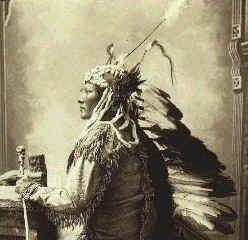
Chief Rain In The Face
During his youth, Rain In The Face rose to prominence as a warrior and was a major leader in the Lakota wars of the 1860s and 1870s. Following the Battle of the Little Bighorn, he accompanied Sitting Bull to Canada and returned with him to the United States in 1881. Like many other former Lakota warriors he became a reservation policeman, performing many of the traditional functions of an akicita or camp patrolman.

Sitting Bull - Tatanka Iyotake
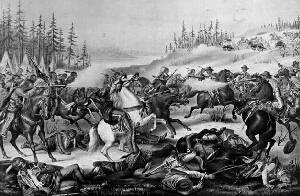
- He was a Lakota Medicine Man and Chief was considered the last Sioux to surrender to the U.S. Government. He was a Native American shaman and leader of the Hunkpapa Sioux, who led 3,500 Sioux and Cheyenne warriors against the US 7th Cavalry under George Armstrong Custer at the Battle of Little Bighorn on June 25, 1876. Though he did not participate personally in the battle, the chiefs were spurred on by a dream that Sitting Bull had in which a group of American soldiers tumbled into his encampment. Blamed for the ensuing massacre, Sitting Bull led his tribe into Canada, where they lived until 1881, when on July 20 he led the last of his fugitive people in surrender to United States troops at Fort Buford in Montana. The US government, however, had granted him amnesty. In later life, Sitting Bull toured with Buffalo Bill Cody's Wild West Show, where he was a popular attraction. Often asked to address the audience, he frequently cursed them in his native Lakota language to the wild applause of his listeners. Toward the end of his life, Sitting Bull was drawn to the mystical Ghost Dance as a way of repelling the white invaders from his people's land. Although he himself was not a follower, this was perceived as a threat by the American government, and a group of Indian police was sent to arrest him. In the ensuing scuffle, Sitting Bull and his son Crow Foot were killed.
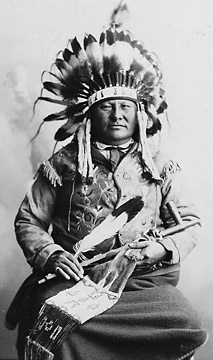
Gall - Man Who Goes In The Middle and Red Walker
Gall (Pizi), known also as Man Who Goes In The Middle and Red Walker, was a close ally and younger brother of Sitting Bull. He is best remembered for mounting the successful counterattack on Commander Marcus Reno's troops during the Battle of the Little Bighorn. Discovering that his wives and children were victims of Reno's assault, Gall threw himself into the remaining conflict with unbridled passion, observing later that their loss had "made his heart bad."
Following the Battle of the Little Bighorn, Gall lived with Sitting Bull's camp in Canada from 1877 to 1881. Returning to the United States, he joined the rest of the Hunkpapas on Standing Rock Reservation where he attempted to help his people adapt to the changes demanded of them by assimilationist polices. His willingness to cooperate with white officials led Sitting Bull and other traditionalists to brand him a traitor. Gall died in Oak Creek, South Dakota in 1894.
Following the Battle of the Little Bighorn, Gall lived with Sitting Bull's camp in Canada from 1877 to 1881. Returning to the United States, he joined the rest of the Hunkpapas on Standing Rock Reservation where he attempted to help his people adapt to the changes demanded of them by assimilationist polices. His willingness to cooperate with white officials led Sitting Bull and other traditionalists to brand him a traitor. Gall died in Oak Creek, South Dakota in 1894.
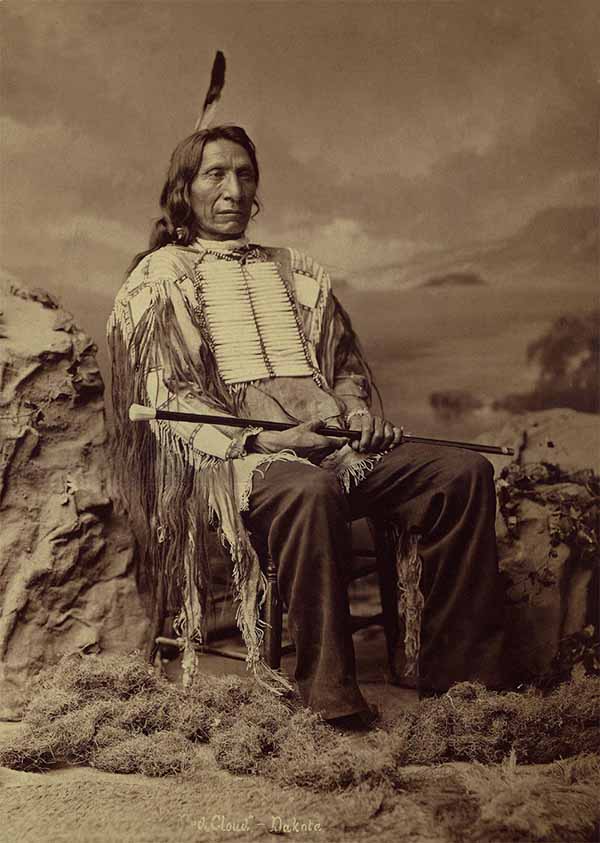
Red Cloud - Makhpiya-Luta
Beginning in 1866, Red Cloud orchestrated the most successful war against the United States ever fought by an Indian nation. The army had begun to construct forts along the Bozeman Trail, which ran through the heart of Lakota territory in present-day Wyoming to the Montana gold fields from Colorado's South Platte River. As caravans of miners and settlers began to cross the Lakota's land, Red Cloud was haunted by the vision of Minnesota's expulsion of the Eastern Lakota in 1862 and 1863.
So he launched a series of assaults on the forts, most notably the crushing defeat of Lieutenant Colonel William Fetterman's column of eighty men just outside Fort Phil Kearny, Wyoming, in December of 1866. The garrisons were kept in a state of exhausting fear of further attacks through the rest of the winter.
Red Cloud's strategies were so successful that by 1868 the United States government had agreed to the Fort Laramie Treaty. The treaty's remarkable provisions mandated that the United States abandon its forts along the Bozeman Trail and guarantee the Lakota their possession of what is now the Western half of South Dakota, including the Black Hills, along with much of Montana and Wyoming.
The peace, of course, did not last. Custer's 1874 Black Hills expedition again brought war to the northern Plains, a war that would mean the end of independent Indian nations. For reasons which are not entirely clear, Red Cloud did not join Crazy Horse, Sitting Bull and other war leaders in the Lakota War of 1876-77. However, after the military defeat of the Lakota nation, Red Cloud continued to fight for the needs and autonomy of his people, even if in less obvious or dramatic ways than waging war.
Throughout the 1880's Red Cloud struggled with Pine Ridge Indian Agent Valentine McGillycuddy over the distribution of government food and supplies and the control of the Indian police force. He was eventually successful in securing McGillycuddy's dismissal. Red Cloud cultivated contacts with sympathetic Eastern reformers, especially Thomas A. Bland, and was not above pretending for political effect to be more acculturated to white ways than he actually was.
Fearing the Army's presence on his reservation, Red Cloud refrained from endorsing the Ghost Dance movement, and unlike Sitting Bull and Big Foot, he escaped the Army's occupation unscathed. Thereafter he continued to fight to preserve the authority of chiefs such as himself, opposed leasing Lakota lands to whites, and vainly fought allotment of Indian reservations into individual tracts under the 1887 Dawes Act. He died in 1909, but his long and complex life endures as testimony to the variety of ways in which Indians resisted their conquest.
So he launched a series of assaults on the forts, most notably the crushing defeat of Lieutenant Colonel William Fetterman's column of eighty men just outside Fort Phil Kearny, Wyoming, in December of 1866. The garrisons were kept in a state of exhausting fear of further attacks through the rest of the winter.
Red Cloud's strategies were so successful that by 1868 the United States government had agreed to the Fort Laramie Treaty. The treaty's remarkable provisions mandated that the United States abandon its forts along the Bozeman Trail and guarantee the Lakota their possession of what is now the Western half of South Dakota, including the Black Hills, along with much of Montana and Wyoming.
The peace, of course, did not last. Custer's 1874 Black Hills expedition again brought war to the northern Plains, a war that would mean the end of independent Indian nations. For reasons which are not entirely clear, Red Cloud did not join Crazy Horse, Sitting Bull and other war leaders in the Lakota War of 1876-77. However, after the military defeat of the Lakota nation, Red Cloud continued to fight for the needs and autonomy of his people, even if in less obvious or dramatic ways than waging war.
Throughout the 1880's Red Cloud struggled with Pine Ridge Indian Agent Valentine McGillycuddy over the distribution of government food and supplies and the control of the Indian police force. He was eventually successful in securing McGillycuddy's dismissal. Red Cloud cultivated contacts with sympathetic Eastern reformers, especially Thomas A. Bland, and was not above pretending for political effect to be more acculturated to white ways than he actually was.
Fearing the Army's presence on his reservation, Red Cloud refrained from endorsing the Ghost Dance movement, and unlike Sitting Bull and Big Foot, he escaped the Army's occupation unscathed. Thereafter he continued to fight to preserve the authority of chiefs such as himself, opposed leasing Lakota lands to whites, and vainly fought allotment of Indian reservations into individual tracts under the 1887 Dawes Act. He died in 1909, but his long and complex life endures as testimony to the variety of ways in which Indians resisted their conquest.
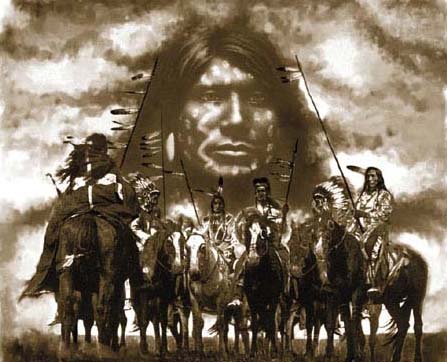
Crazy Horse - Tashunca-uitco
Celebrated for his ferocity in battle, Crazy Horse was recognized among his own people as a visionary leader committed to preserving the traditions and values of the Lakota way of life.
Even as a young man, Crazy Horse was a legendary warrior. He stole horses from the Crow Indians before he was thirteen, and led his first war party before turning twenty. Crazy Horse fought in the 1865-68 war led by the Oglala chief Red Cloud against American settlers in Wyoming, and played a key role in destroying William J. Fetterman's brigade at Fort Phil Kearny in 1867.
Crazy Horse earned his reputation among the Lakota not only by his skill and daring in battle but also by his fierce determination to preserve his people's traditional way of life. He refused, for example, to allow any photographs to be taken of him. And he fought to prevent American encroachment on Lakota lands following the Fort Laramie Treaty of 1868, helping to attack a surveying party sent into the Black Hills by General George Armstrong Custer in 1873.
When the War Department ordered all Lakota bands onto their reservations in 1876, Crazy Horse became a leader of the resistance. Closely allied to the Cheyenne through his first marriage to a Cheyenne woman, he gathered a force of 1,200 Oglala and Cheyenne at his village and turned back General George Crook on June 17, 1876, as Crook tried to advance up Rosebud Creek toward Sitting Bull's encampment on the Little Bighorn.
After this victory, Crazy Horse joined forces with Sitting Bull and on June 25 led his band in the counterattack that destroyed Custer's Seventh Cavalry, flanking the Americans from the north and west as Hunkpapa warriors led by chief Gall charged from the south and east.
Following the Lakota victory at the Little Bighorn, Sitting Bull and Gall retreated to Canada, but Crazy Horse remained to battle General Nelson Miles as he pursued the Lakota and their allies relentlessly throughout the winter of 1876-77. This constant military harassment and the decline of the buffalo population eventually forced Crazy Horse to surrender on May 6, 1877; except for Gall and Sitting Bull, he was the last important chief to yield.
Even in defeat, Crazy Horse remained an independent spirit, and in September 1877, when he left the reservation without authorization, to take his sick wife to her parents, General George Crook ordered him arrested, fearing that he was plotting a return to battle. Crazy Horse did not resist arrest at first, but when he realized that he was being led to a guardhouse, he began to struggle, and while his arms were held by one of the arresting officers, a soldier ran him through with a bayonet.
Even as a young man, Crazy Horse was a legendary warrior. He stole horses from the Crow Indians before he was thirteen, and led his first war party before turning twenty. Crazy Horse fought in the 1865-68 war led by the Oglala chief Red Cloud against American settlers in Wyoming, and played a key role in destroying William J. Fetterman's brigade at Fort Phil Kearny in 1867.
Crazy Horse earned his reputation among the Lakota not only by his skill and daring in battle but also by his fierce determination to preserve his people's traditional way of life. He refused, for example, to allow any photographs to be taken of him. And he fought to prevent American encroachment on Lakota lands following the Fort Laramie Treaty of 1868, helping to attack a surveying party sent into the Black Hills by General George Armstrong Custer in 1873.
When the War Department ordered all Lakota bands onto their reservations in 1876, Crazy Horse became a leader of the resistance. Closely allied to the Cheyenne through his first marriage to a Cheyenne woman, he gathered a force of 1,200 Oglala and Cheyenne at his village and turned back General George Crook on June 17, 1876, as Crook tried to advance up Rosebud Creek toward Sitting Bull's encampment on the Little Bighorn.
After this victory, Crazy Horse joined forces with Sitting Bull and on June 25 led his band in the counterattack that destroyed Custer's Seventh Cavalry, flanking the Americans from the north and west as Hunkpapa warriors led by chief Gall charged from the south and east.
Following the Lakota victory at the Little Bighorn, Sitting Bull and Gall retreated to Canada, but Crazy Horse remained to battle General Nelson Miles as he pursued the Lakota and their allies relentlessly throughout the winter of 1876-77. This constant military harassment and the decline of the buffalo population eventually forced Crazy Horse to surrender on May 6, 1877; except for Gall and Sitting Bull, he was the last important chief to yield.
Even in defeat, Crazy Horse remained an independent spirit, and in September 1877, when he left the reservation without authorization, to take his sick wife to her parents, General George Crook ordered him arrested, fearing that he was plotting a return to battle. Crazy Horse did not resist arrest at first, but when he realized that he was being led to a guardhouse, he began to struggle, and while his arms were held by one of the arresting officers, a soldier ran him through with a bayonet.
The Seven Rites of the Lakota Sioux
Inipi:The Rite of Purification
Hanblecheyapi:Crying for a Vision
Wiwanyag Wachipi:The Sun Dance
Hunkapi:The Making of Relatives
Ishna Ta Awi Cha Lowan:Preparing a Girl for Womanhood Tapa Wanka Yap:Throwing of the Ball
Dream Catcher (Lakota) Legend

Lakota Creation Myth

Wohpe
Among numerous other spirits, the most important is Inktomi ("spider"), the devious trickster. Inktomi conspires with Old Man and Old Woman to increase their daughter's status by arranging an affair between the Sun and Ite.
The discovery of the affair by the Sun's wife leads to a number of punishments by Takuskanskan, who gives the Moon her own domain, and by separating her from the Sun initiates the creation of time.
Old Man, Old Woman, and Ite are sent to Earth, but Ite is separated from the Wind, her husband, who, along with the Four Winds and a fifth wind presumed to be the child of the adulterous affair, establishes space.
The daughter of the Sun and the Moon, Wohpe, also falls to earth and later resides with the South Wind, the paragon of Lakota maleness, and the two adopt the fifth wind, called Wamniomni ("whirlwind").
The Emergence
Alone on the newly formed Earth, some of the gods become bored, and Ite prevails upon Inktomi to find her people, the Buffalo Nation.
In the form of a wolf, Inktomi travels beneath the earth and discovers a village of humans. Inktomi tells them about the wonders of the Earth and convinces one man, Tokahe ("the first"), to accompany him to the surface.
Tokahe does so and upon reaching the surface through a cave (Wind Cave in the Black Hills), marvels at the green grass and blue sky. Inktomi and Ite introduce Tokahe to buffalo meat and soup and show him tipis, clothing, and hunting utensils. Tokahe returns to the subterranean village and appeals to six other men and their families to travel with him to the Earth's surface.
When they arrive, they discover that Inktomi has deceived them: buffalo are scarce, the weather has turned bad, and they find themselves starving. Unable to return to their home, but armed with a new knowledge about the world, they survive to become the founders of the Seven Fireplaces.
The Seven Sacred Rites
Wohpe ("Falling Star") appears to the Lakota as a real woman during a period of starvation. She is discovered by two hunters, one of whom lusts for her. He is immediately covered by a mist and reduced to bones.
The other hunter is instructed to return to his camp and tell the chief and people that she, "White Buffalo Calf Woman," will appear to them the next day. He obeys, and a great council tipi is constructed.
White Buffalo Calf Woman presents to the people a bundle containing the sacred pipe, and she tells them that in time of need they should smoke from the pipe and pray to Wakantanka for help. The smoke from the pipe will carry their prayers upward.
She then instructs them in the seven sacred rites, most of which continue to form the basis of Lakota religion, including the sweat lodge, the vision quest, and the Sundance Day.
- Encyclopedia of Religion
Long ago when the world was young, an old Lakota spiritual leader was on a high mountain and had a vision.
In his vision, Iktomi, the great trickster and teacher of wisdom, appeared in the form of a spider.
Iktomi spoke to him in a sacred language that only the spiritual leaders of the Lakota could understand.
As he spoke Iktomi, the spider, took the elder's willow hoop which had feathers, horse hair, beads and offerings on it and began to spin a web.
He spoke to the elder about the cycles of life ... and how we begin our lives as infants and we move on to childhood, and then to adulthood. Finally, we go to old age where we must be taken care of as infants, completing the cycle.
"But," Iktomi said as he continued to spin his web, "in each time of life there are many forces -- some good and some bad. If you listen to the good forces, they will steer you in the right direction. But if you listen to the bad forces, they will hurt you and steer you in the wrong direction."
He continued, "There are many forces and different directions that can help or interfere with the harmony of nature, and also with the great spirit and-all of his wonderful teachings."
All the while the spider spoke, he continued to weave his web starting from the outside and working toward the center.
When Iktomi finished speaking, he gave the Lakota elder the web and said..."See, the web is a perfect circle but there is a hole in the center of the circle."
He said, "Use the web to help yourself and your people to reach your goals and make good use of your people's ideas, dreams and visions.
"If you believe in the great spirit, the web will catch your good ideas -- and the bad ones will go through the hole."
The Lakota elder passed on his vision to his people and now the Sioux Indians use the dream catcher as the web of their life.
It is hung above their beds or in their home to sift their dreams and visions.
The good in their dreams are captured in the web of life and carried with them...but the evil in their dreams escapes through the hole in the center of the web and are no longer a part of them.
They believe that the dream catcher holds the destiny of their future.
In his vision, Iktomi, the great trickster and teacher of wisdom, appeared in the form of a spider.
Iktomi spoke to him in a sacred language that only the spiritual leaders of the Lakota could understand.
As he spoke Iktomi, the spider, took the elder's willow hoop which had feathers, horse hair, beads and offerings on it and began to spin a web.
He spoke to the elder about the cycles of life ... and how we begin our lives as infants and we move on to childhood, and then to adulthood. Finally, we go to old age where we must be taken care of as infants, completing the cycle.
"But," Iktomi said as he continued to spin his web, "in each time of life there are many forces -- some good and some bad. If you listen to the good forces, they will steer you in the right direction. But if you listen to the bad forces, they will hurt you and steer you in the wrong direction."
He continued, "There are many forces and different directions that can help or interfere with the harmony of nature, and also with the great spirit and-all of his wonderful teachings."
All the while the spider spoke, he continued to weave his web starting from the outside and working toward the center.
When Iktomi finished speaking, he gave the Lakota elder the web and said..."See, the web is a perfect circle but there is a hole in the center of the circle."
He said, "Use the web to help yourself and your people to reach your goals and make good use of your people's ideas, dreams and visions.
"If you believe in the great spirit, the web will catch your good ideas -- and the bad ones will go through the hole."
The Lakota elder passed on his vision to his people and now the Sioux Indians use the dream catcher as the web of their life.
It is hung above their beds or in their home to sift their dreams and visions.
The good in their dreams are captured in the web of life and carried with them...but the evil in their dreams escapes through the hole in the center of the web and are no longer a part of them.
They believe that the dream catcher holds the destiny of their future.
Subscribe to:
Comments (Atom)

